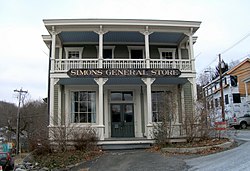Ancram, New York
| Ancram, New York | |
|---|---|
| Town | |

The historic Simons General Store (built 1873–4) in the center of Ancram
|
|
 Location of Ancram, New York |
|
| Coordinates: 42°2′N 73°36′W / 42.033°N 73.600°W | |
| Country | United States |
| State | New York |
| County | Columbia |
| Town of Gallatin | 1803 |
| Government | |
| • Type | Town Council |
| • Town Supervisor | Art Bassin (D) |
| • Town Council |
Members' List
|
| Area | |
| • Total | 42.7 sq mi (110.7 km2) |
| • Land | 42.5 sq mi (110.0 km2) |
| • Water | 0.3 sq mi (0.7 km2) |
| Elevation | 505 ft (154 m) |
| Population (2010) | |
| • Total | 1,573 |
| • Density | 37/sq mi (14.3/km2) |
| Time zone | Eastern (EST) (UTC-5) |
| • Summer (DST) | EDT (UTC-4) |
| ZIP code | 12502 |
| Area code(s) | 518 |
| FIPS code | 36-02099 |
| GNIS feature ID | 0978679 |
| Website | www |
Ancram is a town in Columbia County, New York, United States. The population was 1,573 at the 2010 census. The town was named after Ancram (now Ancrum), Scotland.
Ancram is in the southeast corner of the county.
Prior to European colonization, the area had been occupied for thousands of years by varying indigenous cultures. Historic Native American nations included the Mahican and Wappinger.
Recorded as part of the land grant to the Livingston family, this area on the Roeliff Jansen Kill was originally called "Livingston Forge" after the iron foundry developed on the river. Throughout the eighteenth century, the Livingston forge created metal products for the community. The town was sometimes known as "Scotchtown" due to the immigrants of Scottish ancestry who flocked there in the late 18th century. As the Revolution drew near, the factory produced shot, cannonballs, and perhaps most importantly, the huge chain which was installed across the Hudson River at West Point as a defense against British ships going upriver. The "Fort Montgomery Chain" was worked up in 1776 at the Ancram foundry and placed across the Hudson River near West Point between Fort Montgomery and Fort Clinton. On October 6, 1777, British forces attacked the two forts, choosing to outflank the forts on land rather than test the strength of the chain directly. It is believed that the chain was confiscated by the British forces when they retreated from the fort several weeks later. Its whereabouts is unknown but one prominent British historian surmises it was shipped to Gibraltar to defend shipping in that British colony.
After the Revolution, the town was established from part of the town of Livingston in 1803, and was then called "Gallatin". In 1814, the name was changed to "Ancram", after the town in Scotland where the Livingstons had their origins. Part of Ancram was taken to form a new town of Gallatin in 1830.
...
Wikipedia
